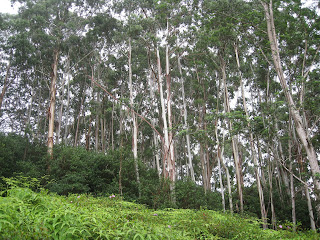

It has been a very good week for Black Oystercatchers in my life.
Monday I attended a meeting that holds promise to have the data that Elise Elliot-Smith, a biologist for the U.S. Geological Survey, has been accumulating for nearly ten years included in the Sea Bird Colony database. Black Oystercatchers are not really seabirds, of course. They are shorebirds. But they nest on the same offshore rocks and rocky shorelines where seabirds nest and so have been counted on seabird colony counts. But they don't really fit anywhere, thus the data that all we volunteers have been collecting for Elise has been in a sort of limbo without a permanent home. It is particularly in danger now that funding has been cut for Elise's work with BLOY. The project has become a volunteer project... and will be until new funding can be secured. And that will be tough in these times. Elise is volunteering her off-work time to keep the project going.
And so, with the possibility that the U.S. Fish and Wildlife service may give our data a permanent home, it was with more of a sense of purpose than I've had lately that I checked on the remaining viable BLOY nests in my jurisdiction. And, for once, the news was all good. BLOY don't have a great record of successful nesting. Last year only one of the nests I watched produced fledglings. We need long term studies... with easily accessible data... to know if this bird, designated a bird of special concern because of few worldwide numbers, is holding its own or not.
One of my most difficult nests to monitor is at Cape Kiwanda. The BLOY build their scrape of a nest on Haystack Rock, a mile offshore.
 |
| Haystack Rock as close as we can get to it from the end of the Cape |
This year they made life even more difficult by hiding their nest behind a rock wall. We had to watch through a scope for hours on end for the one moment when a tiny (at that distance) black bird with a red bill flew in and landed atop the rock wall and then disappeared behind it, signifying an incubation exchange. But then for several weeks, after the eggs should have hatched, we saw nothing. I had about decided the nest had failed.
 |
| The nest ledge with the pesky rock wall as seen with my camera at full zoom. |
This past Wednesday, Johnny and I climbed the dune to look down on the tidal flats where BLOY and their fledglings, when they have any, feed...
and found the missing birds! Two adults and two fledglings! Hooray! You can tell the fledglings from the adults by their shorter bills that are not yet entirely red.
These two photos were taken by Johnny through the scope. Adult on the left; fledgling on the right.


I took photos of the family with my new camera and its long zoom on the tidal flats (photos at beginning of this blog) and (below) after they had flown to a tidal area at the end of the cape when scared off the flats by an approaching fisherman.
Here are one adult and one juvenile. Juveniles do not yet have the bright red eyes of the adults.
I know of only one other nest that I monitor with the possibility of success this year. That is one of the three nests at Road's End near Lincoln City. This year that pair lost their chicks soon after hatching... but renested and produced a second brood. I knew they were feeding chicks because I could see the adults bringing food and disappearing behind a rock wall. (These offshore rocks are full of rock walls to hide chicks from potential predators... and my eyes.)
This week those chicks should have been one month old, but, in spite of weekly visits, I had yet to see them. Yesterday, Friday, two friends and I climbed The Thumb where we can look down on all three nest rocks. Here is our view with the big rock in the middle that has the still active nesting pair.
Adults were hanging out at the nest site but not feeding... at first. However, we sat and waited and our wait was rewarded when one adult flew out to forage and brought back food... a sure sign that at least one chick had survived. And soon we saw that chick. Later, two chicks were in sight at the same time. These chicks are much harder to detect than fledglings because they are still downy gray with very little color to their quite short bills. Gray chicks against gray rocks at a considerable distance from the viewer need to move to be seen.
A cropped version of the above photo is below: two adults on either side with two chicks in the middle dip.
The youngsters have survived a month. Here's hoping they make it another two or three weeks to fledging.
Julie and Nancy were all smiles after seeing the chicks, in spite of fog moving in behind them.
Below are my intrepid friends descending The Thumb... and gazing out at the view from the foot... as the intermittent fog cleared again.
It was a very good day, with good friends, ending a very good week.
















































